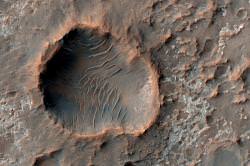Here’s an interesting image released today captured by NASA’s Mars Reconnaissance Orbiter. It’s of an unnamed crater on Mars in the Terra Cimmeria region that could contain ancient deposits of chloride salts. The region is one of the most geologically interesting on Mars. It’s riddled with impact craters, crisscrossed by dried up river channels, and sculpted by wind. Water probably acted on the region a long time ago, building up the salt deposits.
This region of Mars is of great interest to scientists. Three separate missions have studied the area in great detail: Mars Global Surveyor, Mars Odyssey, and now the Mars Reconnaissance Orbiter. Over the years, they have shown how these small deposits of chloride salts are scattered across the Martian surface.
They’re more widely found in the Noachian (most ancient) regions, and less found in the Hesperian (middle geologic time) terrain. This means that the deposits were probably laid down in the earliest epochs of Martian history, and then later geologic processes resurfaced them.
This image, captured by the HiRISE instrument on NASA’s Mars Reconnaissance Orbiter shows one of these deposits. The photograph reveals an area about 900 metres across, including a partially buried unnamed crater in Terra Cimmeria. The chloride salt deposits in this photograph are the lighter toned colour. The deposits are relatively thin and occur in low lying areas. This one has been heavily eroded, which suggests that it’s very old.
Original Source: HiRISE News Release


nasa is truly having a hard time getting close up pictures of mars. why?